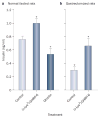Actions and therapeutic pathways of ghrelin for gastrointestinal disorders
- PMID: 19434096
- PMCID: PMC3898933
- DOI: 10.1038/nrgastro.2009.72
Actions and therapeutic pathways of ghrelin for gastrointestinal disorders
Abstract
Ghrelin is a peptide hormone that possesses unique orexigenic properties. By acting on the growth-hormone secretagogue receptor 1a, ghrelin induces a short-term increase in food consumption, which ultimately induces a positive energy balance and increases fat deposition. Reduced ghrelin levels have been observed in obese patients and after bariatric surgery. In particular, bariatric procedures that involve gastric resection or bypass lead to reduced ghrelin levels. Administration of physiological doses of exogenous ghrelin to humans does not significantly alter gastric motility; however, administration of high doses stimulates gastric motility, with increased gastric tone and emptying, and increased activity of migrating motor complexes in the small bowel. The potential of ghrelin agonists to be used as prokinetics is being tested in patients with gastroparesis and postoperative ileus. Ghrelin acts directly on pancreatic islet cells to reduce insulin production. Findings from studies in animals have revealed that small-molecule ghrelin antagonists favorably influence glucose tolerance, appetite suppression and weight loss. Other studies have demonstrated that ghrelin antagonists retard gastric emptying only at very high doses, which suggests that these agents will probably not induce upper gastrointestinal symptoms. The potential of this new class of therapeutic agents to influence appetite and glycemic control strongly indicates that they should be tested in clinical trials.
Conflict of interest statement
The authors declare no competing interests.
Figures



References
-
- Asakawa A, et al. Ghrelin is an appetite-stimulatory signal from stomach with structural resemblance to motilin. Gastroenterology. 2001;120:337–345. - PubMed
-
- Kojima M, et al. Ghrelin is a growth-hormone-releasing acylated peptide from stomach. Nature. 1999;402:656–660. - PubMed
-
- Howard AD, et al. A receptor in pituitary and hypothalamus that functions in growth hormone release. Science. 1996;273:974–977. - PubMed
-
- Bowers CY, et al. Structure–activity relationships of a synthetic pentapeptide that specifically releases growth hormone in vitro. Endocrinology. 1980;106:663–667. - PubMed
-
- Wren AM, et al. The novel hypothalamic peptide ghrelin stimulates food intake and growth hormone secretion. Endocrinology. 2000;141:4325–4328. - PubMed
Publication types
MeSH terms
Substances
Grants and funding
LinkOut - more resources
Full Text Sources
Other Literature Sources

